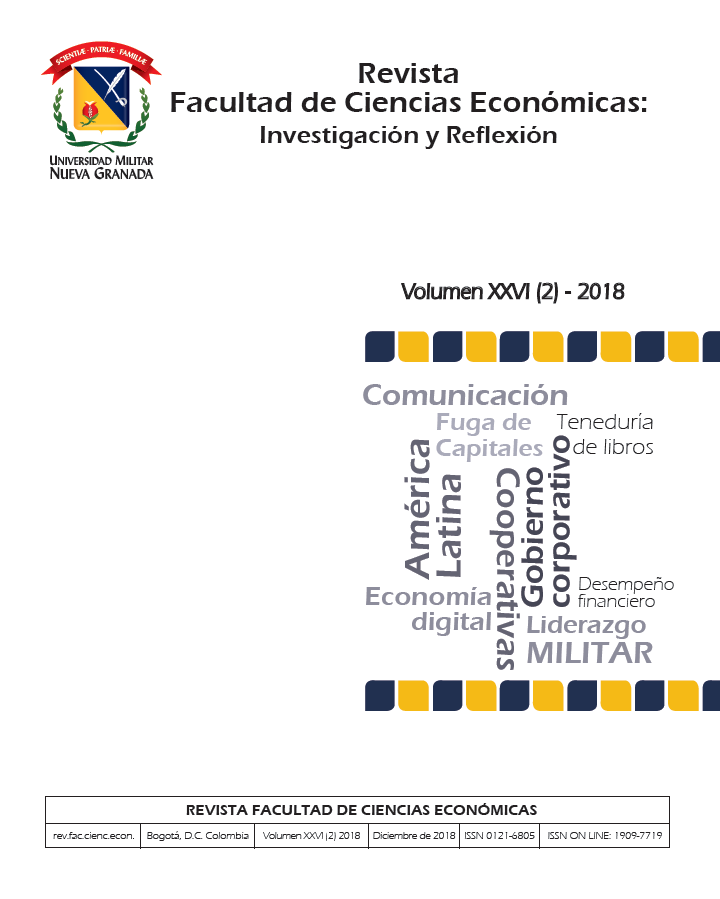Perspective-taking and corporate social responsibility communication: a conceptual review
Abstract
This is the first product of an ongoing research project focused on Corporate Social Responsibility (CSR) communication. It is stated that companies make mistakes in CSR communication processes, one of which is not to raise awareness of CSR activities among consumers because of their failure to disseminate programs or consumer’s disregard of the importance of CSR activities. Finding the most effective way to keep consumers informed, without losing credibility, plays an important role in the strategic objectives of CSR. In the framework of the CSR communication model, perspective-taking (cognitive empathy, role-taking) emerges as a concept that has not yet been analyzed in light of the literature on marketing communication and consumer’s behavior, as an alternative in designing contents related to and aimed at influencing stakeholders. Some concepts and their alternatives are reviewed.Downloads
Languages:
esReferences
Ackerman, R. W. (1973). How companies respond to social demands. Harvard Business Review, 51(4), 88-98.
Andreu, L., Casado-Díaz, A. B. y Mattila, A. S. (2015). Effects of message appeal and service type in CSR communication strategies. Journal of Business Research, 68(7), 1488-1495. https://doi.org/10.1016/j.jbusres.2015.01.039
Andreu, L., Mattila, A. S. y Aldás, J. (2011). Effects of message appeal when communicating CSR initiatives. En S. Okazaki (ed.), Advances in advertising research (vol. 2, pp. 261-275). Gabler. https://doi.org/10.1007/978-3-8349-6854-8_17
Barrett-Lennard, G. T. (1981). The empathy cycle: Refinement of a nuclear concept. Journal of Counseling Psychology, 28(2), 91-100. https://doi.org/10.1037/0022-0167.28.2.91
Batra, R. y Ray, M. L. (1986). Affective responses mediating acceptance of advertising. Journal of Consumer Research, 13(2), 234-249. https://doi.org/10.1086/209063
Batson, C. D. (1987). Prosocial motivation: ¿Is it ever altruistic? En L. Berkowitz (ed.), Advances in experimental social psychology (pp. 65-123). Nueva York: Academic Press.
Batson, C. D., Bolen, M. H., Cross, J. A. y Neuringer-Benefiel, H. E. (1986). Where is the altruism in the altruistic personality? Journal of Personality and Social Psychology, 50(1), 212-220. https://doi.org/10.1037/0022-3514.50.1.212
Bhattacharya, C. B. y Sen, S. (2003). Consumer-company identification: A framework for understanding consumers' relationships with companies. Journal of Marketing, 67(2), 76-88. https://doi.org/10.1509/jmkg.67.2.76.18609
Bhattacharya, C. B. y Sen, S. (2004). Doing better at doing good: When, why, and how consumers respond to corporate social initiatives. California Management Review, 47(1), 9-24. https://doi.org/10.2307/41166284
Bhattacharya, C. B., Rao, H. y Glynn, M. A. (1995). Understanding the bond of identification: An investigation of its correlates among art museum members. Journal of Marketing, 59(4), 46-57. https://doi.org/10.1177/002224299505900404
Bigné-Alca-iz, E., Chumpitaz, R., Andreu, L. y Swaen, V. (2005). Percepción de la responsabilidad social corporativa: un análisis cross-cultural. Universia Business Review, 1(5), 14-27.
Bigné-Alca-iz, E. y Currás-Pérez, R. (2008). ¿Influye la imagen de responsabilidad social en la intención de compra? El papel de la identificación del consumidor con la empresa. Universia Business Review, 19, 10-23.
Blatt, B., LeLacheur, S. F., Galinsky, A. D., Simmens, S. J. y Greenberg, L. (2010). Does perspective-taking increase patient satisfaction in medical encounters? Academic Medicine, 85(9), 1445-1452. https://doi.org/10.1097/ACM.0b013e3181eae5ec
Brown, T. J. y Dacin, P. A. (1997). The company and the product: Corporate associations and consumer product responses. The Journal of Marketing, 61(1), 68-84. https://doi.org/10.1177/002224299706100106
Carroll, A. B. (1979). A three-dimensional conceptual model of corporate performance. Academy of Management Review, 4(4), 497-505. https://doi.org/10.5465/amr.1979.4498296
Carroll, A. B. (1999). Corporate social responsibility: Evolution of a definitional construct. Business & Society, 38(3), 268-295. https://doi.org/10.1177/000765039903800303
Cho, J. (2009). Disentangling media effects from debate effects: The presentation mode of televised debates and viewer decision making. Journalism & Mass Communication Quarterly, 86(2), 383-400. https://doi.org/10.1177/107769900908600208
Cohen, J. (2001). Defining identification: A theoretical look at the identification of audiences with media characters. Mass Communication & Society, 4(3), 245-264. https://doi.org/10.1207/S15327825MCS0403_01
Cohen, T. R. (2010). Moral emotions and unethical bargaining: The differential effects of empathy and perspective-taking in deterring deceitful negotiation. Journal of Business Ethics, 94(4), 569-579. https://doi.org/10.1007/s10551-009-0338-z
Commission of the European Communities (2001). Promoting a european framework for corporate social responsibilities. Bruselas: Commission of the European Communities.
Coplan, A. (2011). Will the real empathy please stand up? A case for a narrow conceptualization. The Southern Journal of Philosophy, 49, 40-65. https://doi.org/10.1111/j.2041-6962.2011.00056.x
Coutu, W. (1951). Role-playing vs. role-taking: An appeal for clarification. American Sociological Review, 16(2), 180-187. https://doi.org/10.2307/2087691
Cox, C. L., Uddin, L. Q., Di Martino, A., Castellanos, F. X., Milham, M. P. y Kelly, C. (2011). The balance between feeling and knowing: Affective and cognitive empathy are reflected in the brain's intrinsic functional dynamics. Social Cognitive and Affective Neuroscience, 7(6), 727-737. https://doi.org/10.1093/scan/nsr051
Creyer, E. H. (1997). The influence of firm behavior on purchase intention: Do consumers really care about business ethics? Journal of consumer Marketing, 14(6), 421-432. https://doi.org/10.1108/07363769710185999
Cuff, B. M., Brown, S. J., Taylor, L. y Howat, D. J. (2016). Empathy: A review of the concept. Emotion Review, 8(2), 144-153. https://doi.org/10.1177/1754073914558466
Davis, M. H. (1980). A multidimensional approach to individual differences in empathy. Catalog of Selected Documents in Psychology, 10(85), 1-17.
Davis, M. H. (1996). A social psychological approach. Boulder: Westview Press.
Davis, M. H. (2005). Becoming (and remaining) a community volunteer: Does personality matter. En A. M. Omoto (ed.), Processes of community change and social action (pp. 67-82). Mahwah, NJ: Lawrence Erlbaum Associates Publishers.
Dawkins, J. (2005). Corporate responsibility: The communication challenge. Journal of Communication Management, 9(2), 108-119. https://doi.org/10.1108/13632540510621362
Decety, J. (2010). To what extent is the experience of empathy mediated by shared neural circuits? Emotion Review, 2(3), 204-207. https://doi.org/10.1177/1754073910361981
Decety, J. (2011). Dissecting the neural mechanisms mediating empathy. Emotion Review, 3(1), 92-108. https://doi.org/10.1177/1754073910374662
Decety, J. y Chaminade, T. (2003). When the self represents the other: A new cognitive neuroscience view on psychological identification. Consciousness and Cognition, 12(4), 577-596. https://doi.org/10.1016/S1053-8100(03)00076-X
Decety, J. y Cowell, J. M. (2014a). Friends or foes: Is empathy necessary for moral behavior? Perspectives on Psychological Science, 9(5), 525-537. https://doi.org/10.1177/1745691614545130
Decety, J. y Cowell, J. M. (2014b). The complex relation between morality and empathy. Trends in Cognitive Sciences, 18(7), 337-339. https://doi.org/10.1016/j.tics.2014.04.008
De Waal, F. B. (2008). Putting the altruism back into altruism: The evolution of empathy. Annual Review of Psychology, 59, 279-300. https://doi.org/10.1146/annurev.psych.59.103006.093625
Delpechitre, D. (2013). Review and assessment of past empathy scales to measure salesperson's empathy. Journal of Management and Marketing Research, 13.
Devoldre, I., Davis, M. H., Verhofstadt, L. L. y Buysse, A. (2010). Empathy and social support provision in couples: Social support and the need to study the underlying processes. The Journal of psychology, 144(3), 259-284. https://doi.org/10.1080/00223981003648294
Dovidio, J. F., Allen, J. L. y Schroeder, D. A. (1990). Specificity of empathy-induced helping: Evidence for altruistic motivation. Journal of Personality and Social Psychology, 59(2), 249-206. https://doi.org/10.1037/0022-3514.59.2.249
Dymond, R. F. (1949). A scale for the measurement of empathic ability. Journal of Consulting Psychology, 13(2), 127-133. https://doi.org/10.1037/h0061728
Du, S., Bhattacharya, C. B. y Sen, S. (2007). Reaping relational rewards from corporate social responsibility: The role of competitive positioning. International Journal of Research in Marketing, 24(3), 224-241. https://doi.org/10.1016/j.ijresmar.2007.01.001
Du, S., Bhattacharya, C. B. y Sen, S. (2010). Maximizing business returns to corporate social responsibility (CSR): The role of CSR communication. International Journal of Management Reviews, 12(1), 8-19. https://doi.org/10.1111/j.1468-2370.2009.00276.x
Eisenberg, N. y Miller, P. A. (1987). The relation of empathy to prosocial and related behaviors. Psychological Bulletin, 101(1), 91-119. https://doi.org/10.1037/0033-2909.101.1.91
Eisenberg, N. y Morris, A. S. (2001). The origins and social significance of empathy-related responding. A review of empathy and moral development: Implications for caring and justice by ML Hoffman. Social Justice Research, 14(1), 95-120. https://doi.org/10.1023/A:1012579805721
Eisenberg, N., Fabes, R. A. y Spinrad, T. L. (2006). Prosocial development. En W. Damon, R. M. Lerner y N. Eisenberg (eds.), Handbook of child psychology, social, emotional, and personality development (6.ª ed., vol. 3, pp. 646-718). Hoboken: John Wiley y Sons.
Eisenberg, N., Zhou, Q., Spinrad, T. L., Valiente, C., Fabes, R. A. y Liew, J. (2005). Relations among positive parenting, children's effortful control, and externalizing problems: A three‐wave longitudinal study. Child Development, 76(5), 1055-1071. https://doi.org/10.1111/j.1467-8624.2005.00897.x
Eklund, J., Andersson-Stråberg, T. y Hansen, E. M. (2009). "I've also experienced loss and fear": Effects of prior similar experience on empathy. Personality and Social Sciences, 50(1), 65-69. https://doi.org/10.1111/j.1467-9450.2008.00673.x
Ellen, P. S., Webb, D. J. y Mohr, L. A. (2006). Building corporate associations: Consumer attributions for corporate socially responsible programs. Journal of the Academy of Marketing Science, 34(2), 147-157. https://doi.org/10.1177/0092070305284976
Epley, N., Caruso, E. M. y Bazerman, M. H. (2006). When perspective-taking increases taking: Reactive egoism in social interaction. Journal of Personality and Social Psychology, 91(5), 872-889. https://doi.org/10.1037/0022-3514.91.5.872
Fan, Y., Duncan, N. W., de Greck, M. y Northoff, G. (2011). Is there a core neural network in empathy? An fMRI based quantitative meta-analysis. Neuroscience & Biobehavioral Reviews, 35(3), 903-911. https://doi.org/10.1016/j.neubiorev.2010.10.009
Farrant, B. M., Devine, T. A., Maybery, M. T. y Fletcher, J. (2012). Empathy, perspective-taking and prosocial behaviour: The importance of parenting practices. Infant and Child Development, 21(2), 175-188. https://doi.org/10.1002/icd.740
Fazio, R. H. (1990). Multiple processes by which attitudes guide behavior: The mode model as an integrative framework. Advances in Experimental Social Psychology, 23, 75-109. https://doi.org/10.1016/S0065-2601(08)60318-4
Freeman, R. E. (1984). Strategic management: A stakeholder perspective. Boston: Pitman.
Galinsky, A. D. y Moskowitz, G. B. (2000). Perspective-taking: Decreasing stereotype expression, stereotype accessibility, and in-group favoritism. Journal of Personality and Social Psychology, 78(4), 708-724. https://doi.org/10.1037/0022-3514.78.4.708
Galinsky, A. D., Ku, G. y Wang, C. S. (2005). Perspective-taking and self-other overlap: Fostering social bonds and facilitating social coordination. Group Processes & Intergroup Relations, 8(2), 109-124. https://doi.org/10.1177/1368430205051060
Galinsky, A. D., Magee, J. C., Gruenfeld, D. H., Whitson, J. A. y Liljenquist, K. A. (2008). Power reduces the press of the situation: Implications for creativity, conformity, and dissonance. Journal of Personality and Social Psychology, 95(6), 1450-1466. https://doi.org/10.1037/a0012633
Galinsky, A. D., Magee, J. C., Inesi, M. E. y Gruenfeld, D. H. (2006). Power and perspectives not taken. Psychological Science, 17(12), 1068-1074. https://doi.org/10.1111/j.1467-9280.2006.01824.x
Galinsky, A. D., Wang, C. S. y Ku, G. (2008). Perspective-takers behave more stereotypically. Journal of Personality and Social Psychology, 95(2), 404-419. https://doi.org/10.1037/0022-3514.95.2.404
Gee, J. P. (2009). Deep learning properties of good digital games: How far can they go? En U. Ritterfeld, M. Cody y P. Vorderer (eds.), Serious games: Mechanisms and effects (pp. 89-104). Nueva York: Routledge.
Gilin, D., Maddux, W. W., Carpenter, J. y Galinsky, A. D. (2013). When to use your head and when to use your heart: The differential value of perspective-taking versus empathy in competitive interactions. Personality and Social Psychology Bulletin, 39(1), 3-16. https://doi.org/10.1177/0146167212465320
Harjoto, M. A. y Jo, H. (2011). Corporate governance and CSR nexus. Journal of Business Ethics, 100(1), 45-67. https://doi.org/10.1007/s10551-011-0772-6
Hoeffler, S. y Keller, K. L. (2002). Building brand equity through corporate societal marketing. Journal of Public Policy & Marketing, 21(1), 78-89. https://doi.org/10.1509/jppm.21.1.78.17600
Hoffman, M. L. (1982). Affect and moral development. New Directions for Child and Adolescent Development, 1982(16), 83-103. https://doi.org/10.1002/cd.23219821605
Hota, M, y Derbaix. M. (2014) A real child in a virtual world: Children's motives for participating in virtual gaming communities. IESEG working series, MKT-01.
International Organization for Standardization (2010). ISO 26000:2010 - Guidance on social responsibility. Recuperado de http://www.iso.org/iso/catalogue_detail?csnumber=42546
Johnston, M. W. y Marshall, G. W. (1998). Administración de ventas (2.ª ed.). México: McGraw-Hill.
Kalliopuska, M. (1986). Empathy and the experiencing of loneliness. Psychological Reports, 59(3), 1052-1054. https://doi.org/10.2466/pr0.1986.59.3.1052
Kelley, H. H. y Thibaut, J. W. (1978). Interpersonal relations: A theory of interdependence. Nueva York: Wiley.
Klein, J. y Dawar, N. (2004). Corporate social responsibility and consumers' attributions and brand evaluations in a product–harm crisis. International Journal of Research in Marketing, 21(3), 203-217. https://doi.org/10.1016/j.ijresmar.2003.12.003
Knafo, A., Zahn-Waxler, C., Van Hulle, C., Robinson, J. L. y Rhee, S. H. (2008). The developmental origins of a disposition toward empathy: Genetic and environmental contributions. Emotion, 8(6), 737-752. https://doi.org/10.1037/a0014179
Lantos, G. P. (2002). The ethicality of altruistic corporate social responsibility. Journal of Consumer Marketing, 19(3), 205-232. https://doi.org/10.1108/07363760210426049
Lishner, D. A., Batson, C. D. y Huss, E. (2011). Tenderness and sympathy: Distinct empathic emotions elicited by different forms of need. Personality and Social Psychology Bulletin, 37(5), 614-625. https://doi.org/10.1177/0146167211403157
Lindgreen, A., Swaen, V. y Johnston, W. J. (2009). Corporate social responsibility: An empirical investigation of US organizations. Journal of Business Ethics, 85(2), 303-323. https://doi.org/10.1007/s10551-008-9738-8
Litchfield, R. C. y Gentry, R. J. (2010). Perspective-taking as an organizational capability. Strategic Organization, 8(3), 187-205. https://doi.org/10.1177/1476127010374249
Marín, L. y Ruiz, S. (2008). La evaluación de la empresa por el consumidor según sus acciones de RSC. Cuadernos de Economía y Dirección de la Empresa, 11(35), 91-112. https://doi.org/10.1016/S1138-5758(11)70060-3
Marín, L., Cuestas, P. J. y Román, S. (2016). Determinants of consumer attributions of corporate social responsibility. Journal of Business Ethics, 138(2), 247-260. https://doi.org/10.1007/s10551-015-2578-4
Marín, L., Rubio, A. y de Maya, S. R. (2012). Competitiveness as a strategic outcome of corporate social responsibility. Corporate Social Responsibility and Environmental Management, 19(6), 364-376. https://doi.org/10.1002/csr.1288
McBane, D. A. (1995). Empathy and the salesperson: A multidimensional perspective. Psychology & Marketing, 12(4), 349-370. https://doi.org/10.1002/mar.4220120409
Moura-Leite, R. C. y Padgett, R. C. (2011). Historical background of corporate social responsibility. Social Responsibility Journal, 7(4), 528-539. https://doi.org/10.1108/1747111111117511
Newman, G. L. (2012). "Now imagine you're one of them": Using serious games to induce identification with out-groups. Masters Theses & Specialist Projects, 1224. Recuperado de https://digitalcommons.wku.edu/cgi/viewcontent.cgi?referer=https://scholar.google.es/&httpsredir=1&article=2227&context=theses
Parker, S. K. y Axtell, C. M. (2001). Seeing another viewpoint: Antecedents and outcomes of employee perspective-taking. Academy of Management Journal, 44(6), 1085-1100.
Peng, W., Lee, M. y Heeter, C. (2010). The effects of a serious game on role-taking and willingness to help. Journal of Communication, 60(4), 723-742. https://doi.org/10.1111/j.1460-2466.2010.01511.x
Perner, J., Leekam, S. R. y Wimmer, H. (1987). Three‐year‐olds' difficulty with false belief: The case for a conceptual deficit. British Journal of Developmental Psychology, 5(2), 125-137. https://doi.org/10.1111/j.2044-835X.1987.tb01048.x
Piliavin, I. M., Rodin, J. y Piliavin, J. A. (1969). Good samaritanism: An underground phenomenon? Journal of Personality and Social Psychology, 13(4), 289-299. https://doi.org/10.1037/h0028433
Piliavin, J. A., Dovidio, J. F., Gaertner, S. L. y Clark, R. D. III. (1981). Emergency Intervention. Nueva York: Academic.
Pomering, A. y Dolnicar, S. (2009). Assessing the prerequisite of successful CSR implementation: Are consumers aware of CSR initiatives? Journal of Business Ethics, 85(2), 285-301. https://doi.org/10.1007/s10551-008-9729-9
Porter, M. y Kramer, M. (2006). Strategy and society: The link between competitive advantage and corporate social responsibility. Harvard Business Review, 84(12), 78-92.
Pryor, S., Malshe, A. y Paradise, K. (2013). Salesperson listening in the extended sales relationship: An exploration of cognitive, affective, and temporal dimensions. Journal of Personal Selling & Sales Management, 33(2), 185-196. https://doi.org/10.2753/PSS0885-3134330203
Rogers, C. R. (1975). Empathic: An unappreciated way of being. The Counseling Psychologist, 5(2), 2-10. https://doi.org/10.1177/001100007500500202
Sen, S. y Bhattacharya, C. B. (2001). Does doing good always lead to doing better? Consumer reactions to corporate social responsibility. Journal of Marketing Research, 38(2), 225-243. https://doi.org/10.1509/jmkr.38.2.225.18838
Sen, S., Bhattacharya, C. B. y Korschun, D. (2006). The role of corporate social responsibility in strengthening multiple stakeholder relationships: A field experiment. Journal of the Academy of Marketing Science, 34(2), 158-166. https://doi.org/10.1177/0092070305284978
Sheehy, B. (2015). Defining CSR: Problems and solutions. Journal of Business Ethics, 131(3), 625-648. https://doi.org/10.1007/s10551-014-2281-x
Smith, A. (1759). The theory of moral sentiments. Londres: A. Miller. https://doi.org/10.1093/oseo/instance.00042831
Strack, F. y Deutsch, R. (2004). Reflective and impulsive determinants of social behavior. Personality and Social Psychology Review, 8(3), 220-247. https://doi.org/10.1207/s15327957pspr0803_1
Vaish, A., Carpenter, M. y Tomasello, M. (2009). Sympathy through affective perspective-taking and its relation to prosocial behavior in toddlers. Developmental Psychology, 45(2), 534-543. https://doi.org/10.1037/a0014322
Webb, D. J. y Mohr, L. A. (1998). A typology of consumer responses to cause-related marketing: From skeptics to socially concerned. Journal of Public Policy y Marketing, 17(2), 226-238.
Wieseke, D. J., Geigenmüller, A. y Kraus, F. (2012). On the role of empathy in customer-employee interactions. Journal of Service Research, 15(3), 316-331. https://doi.org/10.1177/1094670512439743
Wispé, L. (1986). The distinction between sympathy and empathy: To call forth a concept, a word is needed. Journal of Personality and Social Psychology, 50(2), 314-321. https://doi.org/10.1037/0022-3514.50.2.314
Wood, D. J. (1991). Corporate social performance revisited. Academy of Management Review, 16(4), 691-718. https://doi.org/10.5465/amr.1991.4279616
Wood, D. J. (2010). Measuring corporate social performance: A review. International Journal of Management Reviews, 12(1), 50-84. https://doi.org/10.1111/j.1468-2370.2009.00274.x
Wondra, J. D. y Ellsworth, P. C. (2015). An appraisal theory of empathy and other vicarious emotional experiences. Psychological Review, 122(3), 411-428. https://doi.org/10.1037/a0039252
Watts, P. y Holme, R. (1999). Corporate social responsibility: Meeting changing expectations. Génova: World Business Council for Sustainable Development.
Wouters, P., van Nimwegen, C., van Oostendorp, H. y van der Spek, E. D. (2013). A meta-analysis of the cognitive and motivational effects of serious games. Journal of Educational Psychology, 105(2), 249-265. https://doi.org/10.1037/a0031311
Yang, X. y Rivers, C. (2009). Antecedents of CSR practices in MNCs' subsidiaries: A stakeholder and institutional perspective. Journal of Business Ethics, 86(2), 155-169. https://doi.org/10.1007/s10551-009-0191-0
Yoon, Y., Gürhan‐Canli, Z. y Schwarz, N. (2006). The effect of corporate social responsibility (CSR) activities on companies with bad reputations. Journal of Consumer Psychology, 16(4), 377-390. https://doi.org/10.1207/s15327663jcp1604_9
Zaki, J. (2014). Empathy: A motivated account. Psychological Bulletin, 140(6), 1608-1647. https://doi.org/10.1037/a0037679
| Article metrics | |
|---|---|
| Abstract views | |
| Galley vies | |
| PDF Views | |
| HTML views | |
| Other views | |












